… AROUND THE WORLD IN 80 DAYS 1980
(This week, a continuation of our visit in Hong Kong)
On Saturday, the 8th of March, after returning from our interesting excursion on the Kowloon-Canton Railroad to investigate the Communist boarder, Lucy (my shipboard roomie) and I returned to the SS Universe to rest awhile on our bunks.
We’d grabbed a couple of apples as we passed the dining room, finding the ship strangely still and quiet with a goodly portion of the student body away on a side-trip to mainland China. Neither Lucy nor I had the extra cash required for that, so had stayed behind to explore Hong Kong on our own.
Once refreshed, we decided to venture out again, this time just across the dock to where another ship, the SS Canberra, was berthed. Our hope? Get onboard.
At the time, the Canberra, nicknamed the Great White Whale, was second in size only to the Queen Elisabeth II, and we were sure it would be our only chance to see a true luxury liner up-close and personal.
I didn’t know then that thirty years in the future I’d sail to Europe aboard the Queen Mary, II—practically for free, at that—and get to experience an amazing week’s worth of luxury I’d never forget.
(That was one of those life experiences that teach us, fair or not, that it’s truly who you know, not what you know, that enriches our lives the most. In 1980 the building of the QM2 still lay 23 years in the future, but it would be an astounding TWICE the size and luxury of the QE2.)
Lucy and I “farted around” dockside (as recounted in my journal), trying to decide how to proceed. Soon “we noticed a guy who seemed more or less in charge of something,” so we approached him.
Two days prior, we’d met a nice Australian couple up on Victoria Peak who were passengers aboard the Canberra—it’s what gave us the notion to try to get a closer look at her in the first place—and perhaps that’s also why, when we approached the fella at the base of the gangplank, I suddenly found myself faking a British accent.
Back home in Pennsyltucky I was a theatre major and would later have a larger audience for trying on that accent when I snagged a lead in the play, Round And Round The Garden, but that day I had an audience of two.
Apparently I was convincing enough. The fella believed I was a Brit, and soon Lucy and I were aboard, running about in sheer awe and delight.
I can’t recall what bullshit story we offered; I was wearing a Semester At Sea sweatshirt that day so we didn’t try to pass ourselves off as Canberra passengers who’d absentmindedly disembarked without our ID. We probably gave the names of the couple we’d met, saying they were relatives who’d invited us to visit while mutually berthed in Hong Kong.
The fella confessed surprise a British student was aboard the SS Universe, but there really were a number of foreign students traveling with Semester At Sea—like Myan from Denmark, who I mentioned in part 15—so at least we didn’t lie about that.
The Canberra boasted at least three pools (we counted as we ran from deck to deck), two ballrooms, countless bars, several restaurants, numerous shops, a movie theater, lounges, elevators (lifts), grand staircases, and various sports facilities.
Jubilant, we ran to the topmost observation deck and then all the way aft to the fantail, imagining being passengers on such a ship.
DARE TO COMPARE
You might be thinking, but gee, you were already sailing around the world, already passengers on a ship, right?
But you have to understand, the Universe was the smallest ocean liner sailing the seas. Originally built as a cargo ship in 1953, it was refitted as a passenger ship in 1958 and renamed SS Atlantic.
By the time Lucy and I were sailing aboard her, the Universe had been operating as a “worldwide campus afloat” for 9 years after having been stripped down in 1971 and refitted with classrooms and other campus amenities.
The Canberra had been built with a passenger capacity of 2,238 served by a crew of 900. The Universe? We carried a complement of 800: 500 students and a staff and crew of 300, as I recall.
The Canberra was 820 ft. in length, with a gross tonnage surpassing 49,000; she’d clocked speeds over 29 knots per hour (33.3 mph). At 554 ft. long, the Universe weighed in at just over 18,000 tons and couldn’t have topped 20 knots (23 mph) if we’d all gotten out and pushed.
{For comparison, once built, the QMII would be 1,132 feet long with a capacity for nearly 4,000 souls and a gross tonnage topping 149,200; she’d be capable of 30 knots (35 mph)}
Oh sure, we had some “luxuries” too, such as a pool—when it was filled. Push six picnic tables together and you can imagine the size of it. If twelve of us got in at the same time there was barely room for the volleyball.
Don’t get me wrong. I loved the Universe. Living aboard her was the experience of a lifetime. But class stratification is real, and in the world of cruise ships, we were sailing on the bottom rung, so for Lucy and me, getting aboard the Canberra was like getting on the Concord when you’d been relegated to flying in a Piper Cub all your life.
So yeah, we enjoyed it, and playacting as a Brit only made the experience all the more fun.
THE END OF A LONG DAY GETS LONGER …
When we disembarked, the fella who had been at the bottom of the gangplank and had let us onboard was no longer there. Instead, a pair of more official-looking guards kept watch. Timing is everything they say, and it was a good thing we were coming off instead of trying to get on at that point.
We passed by the guards as though we owned the place, knowing we wouldn’t be asked to show ID to get off and knowing no guard could possibly be acquainted with the more than 2,000 passengers the Canberra was carrying.
By then Lucy was feeling cold and growing tired; we’d had a long, exciting day and she wanted to return to the cabin to sack out for the night. Me? I was still rarin’ to go, so we parted ways.
I caught the ferry across the harbor to Honk Kong and set out for the tram to Victoria Peak.
Halfway up the mountain a low layer of clouds hanging over the city engulfed the tram and the sparkling city below me disappeared from view. One by one, the countless lights of Hong Kong winked out like dying stars.
Getting off at the top, I strolled the path that encircled the peak, relishing the strange, mist-shrouded solitude of being atop a shining city on the other side of the world. It was so dark I could barely make out the normally well-lit path.
The light standards cast an eerie, feeble glow, their illumination barely penetrating the dense fog. For several paces I would be walking in total darkness, unsure of every step, then the dim haze of the next lamp would come into view, looking as if it were turned down low and capped with a starburst halo.
Muted city noises arose from below, disembodied and surreal. It felt to me like I’d entered the setting for some un-aired episode of the Twilight Zone.

Occasionally others did stroll by, but only a few: lovers sharing a romantic moment. Mostly it was just the crickets and me and the drizzling rain as it began to fall, softly tickling the foliage so gently it sounded as though the leaves overhead were giggling as I passed.
There was little mistaking when I reached the windward side of the peak.
A sudden rush of wind nearly sent me over the rail, but I grabbed hold. Exhilarated, I watched great wafts of pale, moonlit clouds curling toward me from the valley below. They danced in the dusky lamplight like the breath of angels guarding the city.
By ten PM I was boarding the tram for the ride back down the mountain. I headed straight to the back seat, knowing the car would be backing down, and sat by the open window.
As the car descended the rain-slicked rails and broke through the cloud cover the city suddenly came back into view like some Asian Bridgadoon. Its myriad lights seemed to wink on in rapid succession as if a hundred thousand stars had fallen and been tossed across the dark blanket of land below.
The evening had become for me a warm and wind-swept wonder, a moment of private magic one only feels from time to time as they wander through life.
The tram reached the quay at the base of the mountain, and I slowly strolled back to the Star Ferry terminal to catch the next harbor crossing. I wrote in my journal of the special charm a bridgeless harbor holds, extolling its aesthetic virtues by observing: “It dons an openness & spaciousness to a city that is otherwise crowded & compact.”
… AND STILL LONGER
Once back on the ship I planned to write in my journal while watching some Chinese TV shows in the student lounge, but the ship’s consoles wouldn’t pick up any local stations. I wound up playing piano instead. Hungry, I munched on a few Nabisco Cameo cookies I found lying nearby—leftovers from some unknown gathering earlier in the evening—and washed them down with a can of TAB.
Before long my friend Ethel wandered in, wanting me to go with her to the Night Market, but I told her I’d adventured enough for one day. She ended up staying and chatting instead.
Soon a pair of British dudes we’d never seen before sauntered into the lounge. They were looking for a student they’d befriended, but we knew she was currently off the ship and told them so, so they decided to hang out with us.
They said they worked over on the Canberra (I guess no one guarded our own gangplank) and were 17 and 18 years old, respectively. One lad was named Steve (I didn’t record his last name) and the other, Gary Marshall.
Talk turned to what it was like to work onboard a cruise ship, and before long Ethel and I had both decided to apply; it would be the ideal way to pay off the student loans we’d taken out to sail on the Universe.
Pay for one voyage, earn a paycheck on the next, right?
Steve and Gary gave us the address where we could send for an application, telling us we might just end up working on the Pacific Princess (The “Love Boat” of the TV Show fame), which was part of the same cruise line that operated the Canberra (yup, the Pacific Princess was an actual ship).
We were “psyched,” I jotted in my journal.
So when the lads informed us the Canberra was about to set sail and they had to get back, we decided to escort them across the pier.
Outside we waited while they boarded then re-appeared on the Canberra’s bow section, an amp and sound system in tow. From there they cranked out tunes while we shouted conversationally back and forth, us on the pier and Steve and Gary on the deck above.
They certainly hadn’t allowed themselves a lot of leeway! Moments later the tugs arrived and went right to work pushing the massive ship away from the pier. Ethel and I ran to the upper floor of the pier’s terminal so we could wave goodbye from their eye level.
We continued to wave farewell to Steve and Gary till the ship was so far out in the harbor they were merely two indistinct young adventurers like ourselves, ones we could no longer see.
Charmed, we ran to the other side of the building to look out at our own ship, berthed on the opposite side of the pier. She was beautiful, and by that point in the semester beginning to feel like our home.
Happily we embarked, inspired by our growing sense of familiarity and entitlement to climb out onto the aft restricted area meant for crew, alone. There, overtired and punchy from the late hour and our lack of sleep, Ethel and I sang songs and grew silly as only college students can who are hyped up on soda, cookies, and burgeoning friendships—especially after I found a broken umbrella to use as a theatrical prop.
We were alone in a strange land, standing on the seam between one day’s end and another day’s dawn, and as it so often does at such moments, the world felt as though it belonged to us—or perhaps that we belonged to the world: one that was ever-widening.
STREETS OF SAN FRAN-SLAUGHTER
Sunday the 9th dawned on our fourth Hong Kong day, and Lucy and I decided to venture out again, this time to see more beaches.
Deep Water Bay and Repulse Bay were on out agenda, but enroute we reconsidered, since they appeared so similar in the brochures we’d picked up. Instead, we stayed on the bus as we passed Deep Water Bay, knowing it went on to Repulse Bay by way of Aberdeen.
I later wrote in my journal that, “We shoulda gone to Deep Water Bay. Aberdeen was so gross I woulda puked if I hadn’t made a quick escape.”
That was because the streets there were lined with butcher shops. Countless carcasses hung in plain view, dripping pools of blood onto the sidewalks as we passed.
“They were disembowing [sic] the pigs in plain view & carving the guts RIGHT ON THE SIDE WALK before wrapping it & selling it,” I recalled in my journal later. “In the bakeries there were flies and bees on the goods & the smell outdid Keelung [Taiwan] by a long shot. Every step I took gross old ladies came at me saying, ‘Sampan? Sampan?’ They’d walk after you 3 blocks trying to get you to rent their goddamned boat. You couldn’t stop to look at a product without them shoving it in your face …”
Not quite ready for prime time, Lucy and I caught the very next bus heading on to Repulse Bay. I’m fairly sure that day planted the seeds of what later became my pursuit of a vegetarian lifestyle.
By 12:44 PM we were relaxing on the beach at Repulse Bay where we snacked and wrote in our journals. I wrote about Repulse Bay in more detail back in part 17, so I won’t reiterate it here. We’ll just skip ahead to LTSD (later, that same day):
After a six PM meal in the dining hall back aboard the Universe, Lucy and I met up with Ethel and ferried back over to Hong Kong to catch the 6A bus for an evening at an Amusement park. It was supposedly a 35 minute ride, but an hour later we were still on the bus and starting to wonder.
I said, “ Well, if we don’t make it to the amusement park, some of these street markets look like they’d be great to walk down.”
Clearly, they weren’t anything like Aberdeen had been for me to have suggested it.
But we finally did arrive at our intended destination, albeit discovering it “noisy & small & jammed.” We went in to see the Chinese opera—a form of entertainment often offered at such venues—and we did enjoy it somewhat, but I later described as, “the off-off-off-off-off Broadway type” of show.
It was “crammed, smokey & asphixiating [sic],” I wrote, so we only stayed for Act I—especially after I went to take a picture of the show and to my great dismay the lens on the expensive Canon I’d borrowed from my sister, Earth, stuck open.
I went outside to try to correct the matter, lamenting the photos I’d lost for having had to expose the film, but managed to fixed it. Relieved, but unimpressed with the so-called Amusement Park, we boarding a bus headed back toward the ship.
At one point we did get off to walk part of the way, enjoying the streets in that part of the city: no street-side butchery there!
Feeling young and free, our youthful spirits lifted, we caught another 6A double-decker bus. This time the three of us climbed to the upper deck, took front row seats, and the rest of the way back to the ship loudly serenaded people on the streets below.
We offered renditions of, It’s A Small World After All, This Land Is Your Land, and several John Denver selections we all knew.
After ferrying across the harbor and still in a collective elevated mood, we were walking through the mall of the Ocean Terminal toward the ship when I lost my grip on the camera. I’d been swinging it by its strap as we skipped along when it flew from my hand.
Horrified, I watched as the camera spun through the air beyond my reach and arched toward the concrete floor out ahead of us. I remember it as if it happened in slow motion. Then:
Ka-POW! It landed lens-first.
Suddenly, the little lens-sticking issue from earlier didn’t seem all that bad. I was sure I’d just destroyed my sister’s Canon and I was devastated. How could I have been so careless?
On the up side, the camera had a decent leather case I never ventured abroad without, and that’s probably the reason the damage wasn’t worse:
The next day I’d worked up the courage to take a closer look, discovering I’d merely broken the glass of the protective lens cap Earth had smartly installed. The rim of the lens it latched to was also slightly dented, but the lens itself and the camera on the whole still functioned fine.
Whew.
I would continue not only to use that camera—far more mindfully, to be sure—for the rest of the voyage (minus the lens cap), but several years hence would purchase a similar SRL camera for myself because I’d come to liked it so much.
In the meantime, Earth let me borrow her Canon for another semester when I took a photography course to satisfy requisite art credits (I can still close my eyes and recall the smell of darkroom chemicals).
My kids were raised in the days before cellphones, so that SRL camera I later bought captured most of the snapshot memories of them I’ve cherished for years.
Know what? I’d love to see one of your fav photos captured by a camera before the days of cellphones. Feel free to post it in comments below along with whatever memories it dusts off as you look at it.
Then be sure to come back next week for another installment of Monday Morning Literary Bric-a-Brac as we wrap up our time in Hong Kong and head back out to sea, destination: Singapore!
Thanks, as always, for visiting with me on another Monday Morning.
I so enjoy our time together. If you’re enjoying this multi-part series on my around-the-world voyage, maybe another series after we get back to the States appeals to you.
Please let me know in comments.
I could take you along as a passenger in my cruiser for several months as I go about recalling my day-to-day life of an ordinary township cop, or I could bring you along for an AFS retrospective to France, 1977, when I was a foreign exchange student.
I also had some rather memorable misadventures as a young mother, which you also might like to read about.
So let me know. And see you again next week!




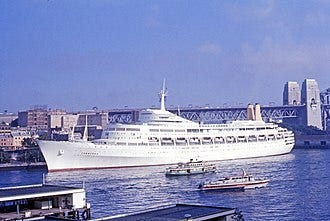
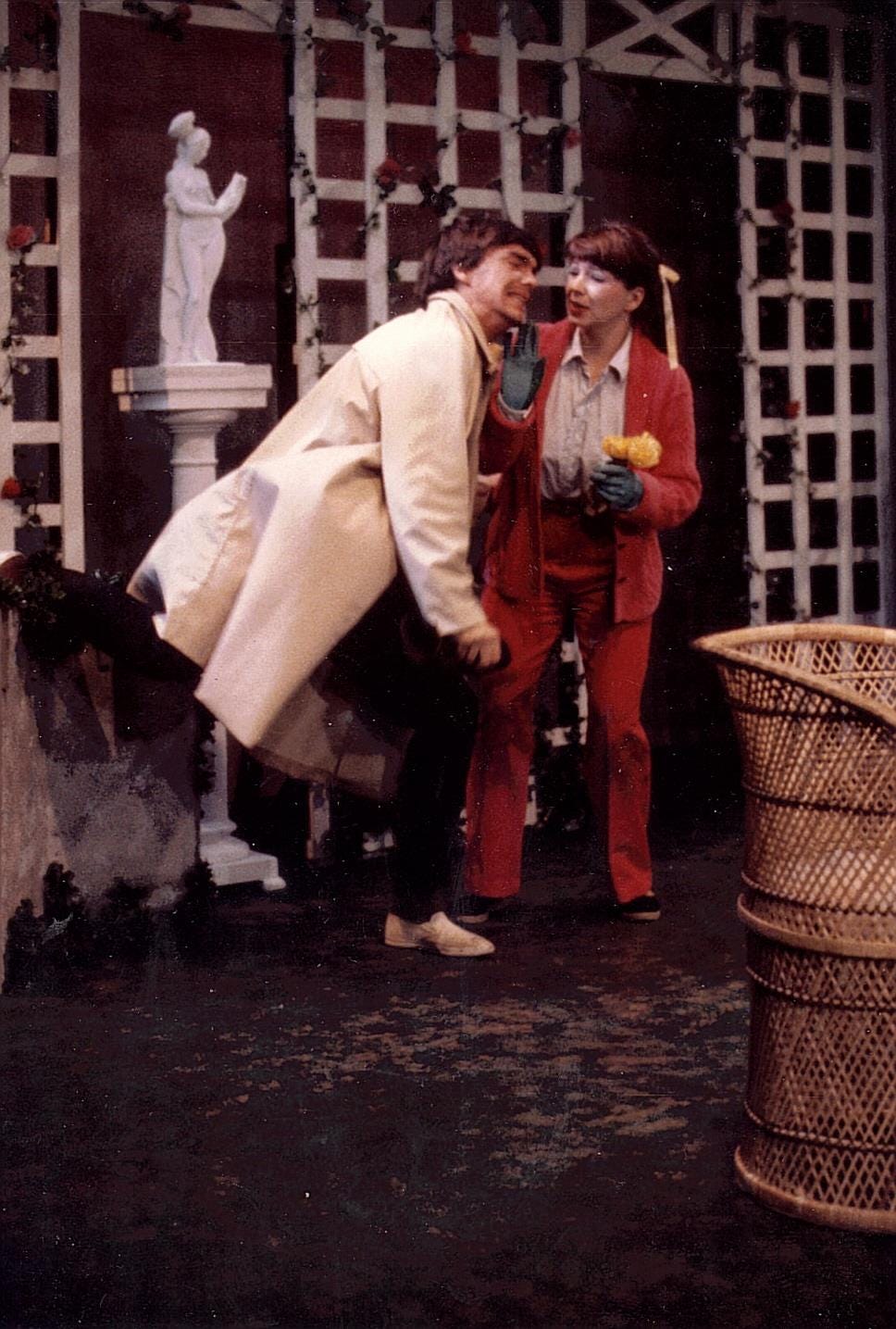
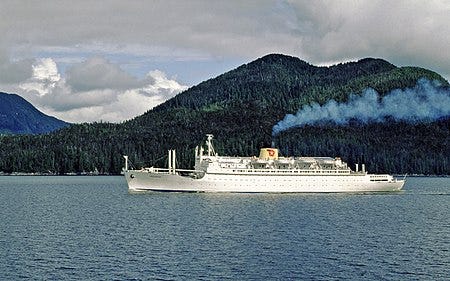
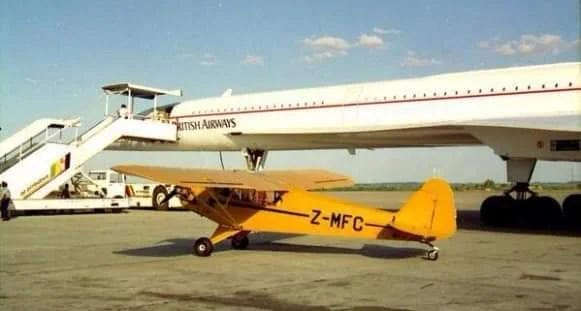
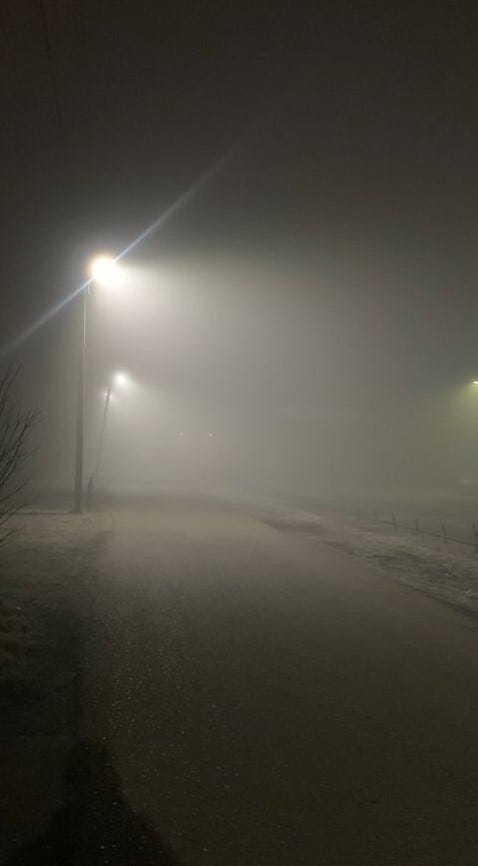
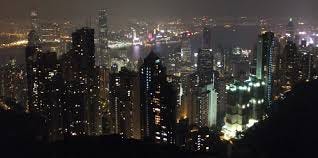
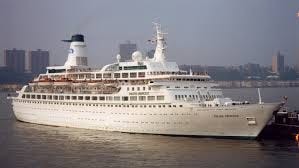
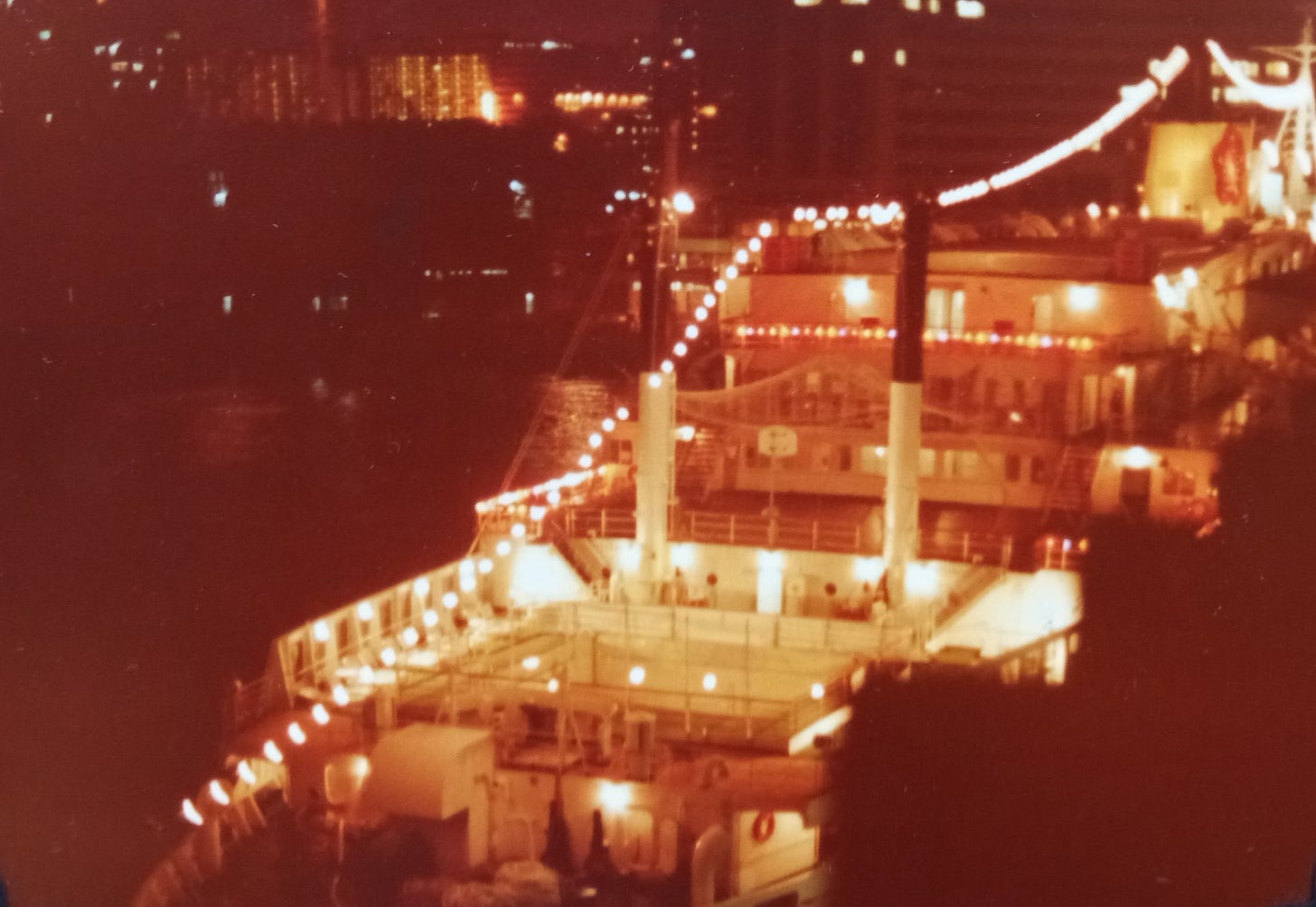
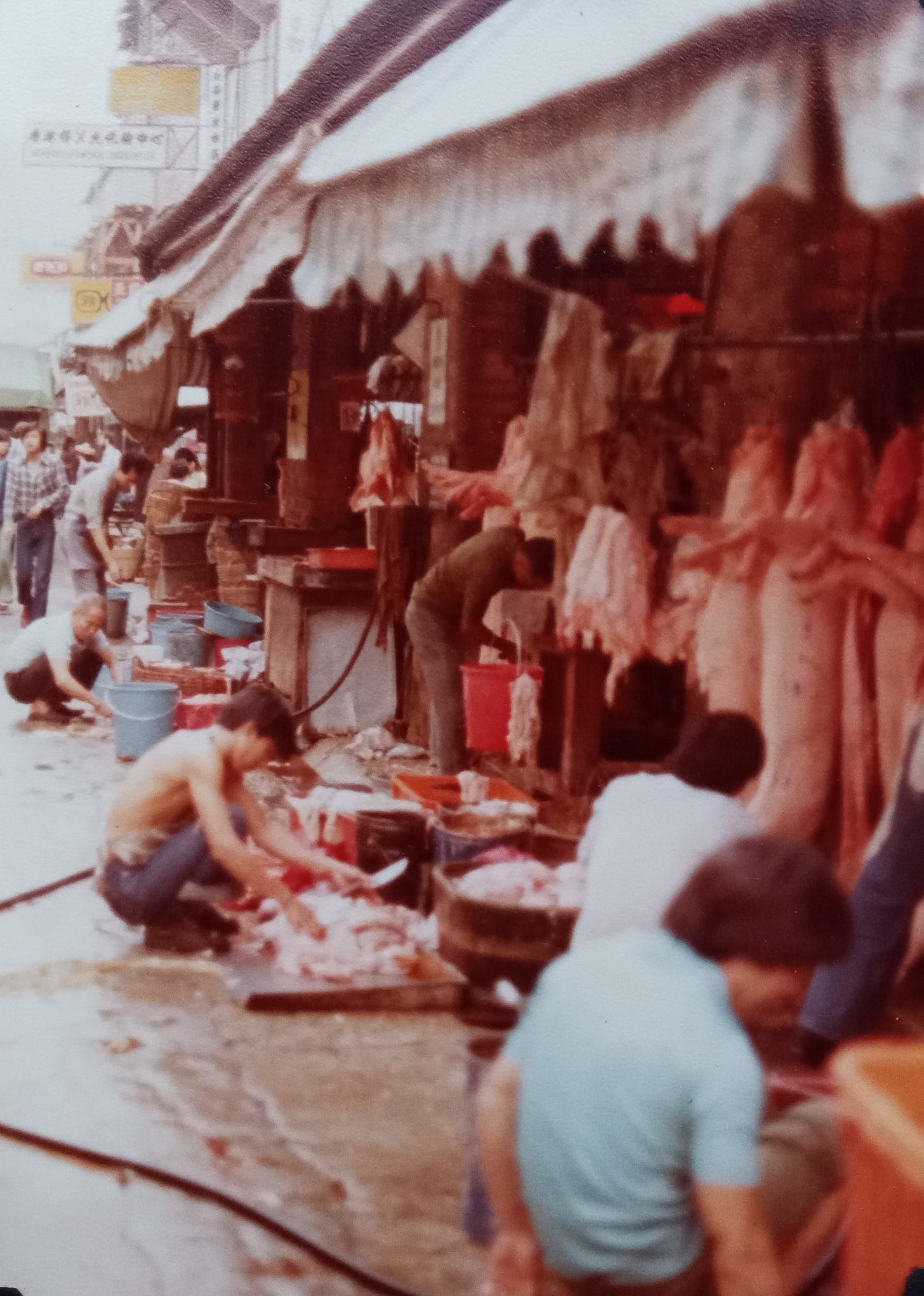
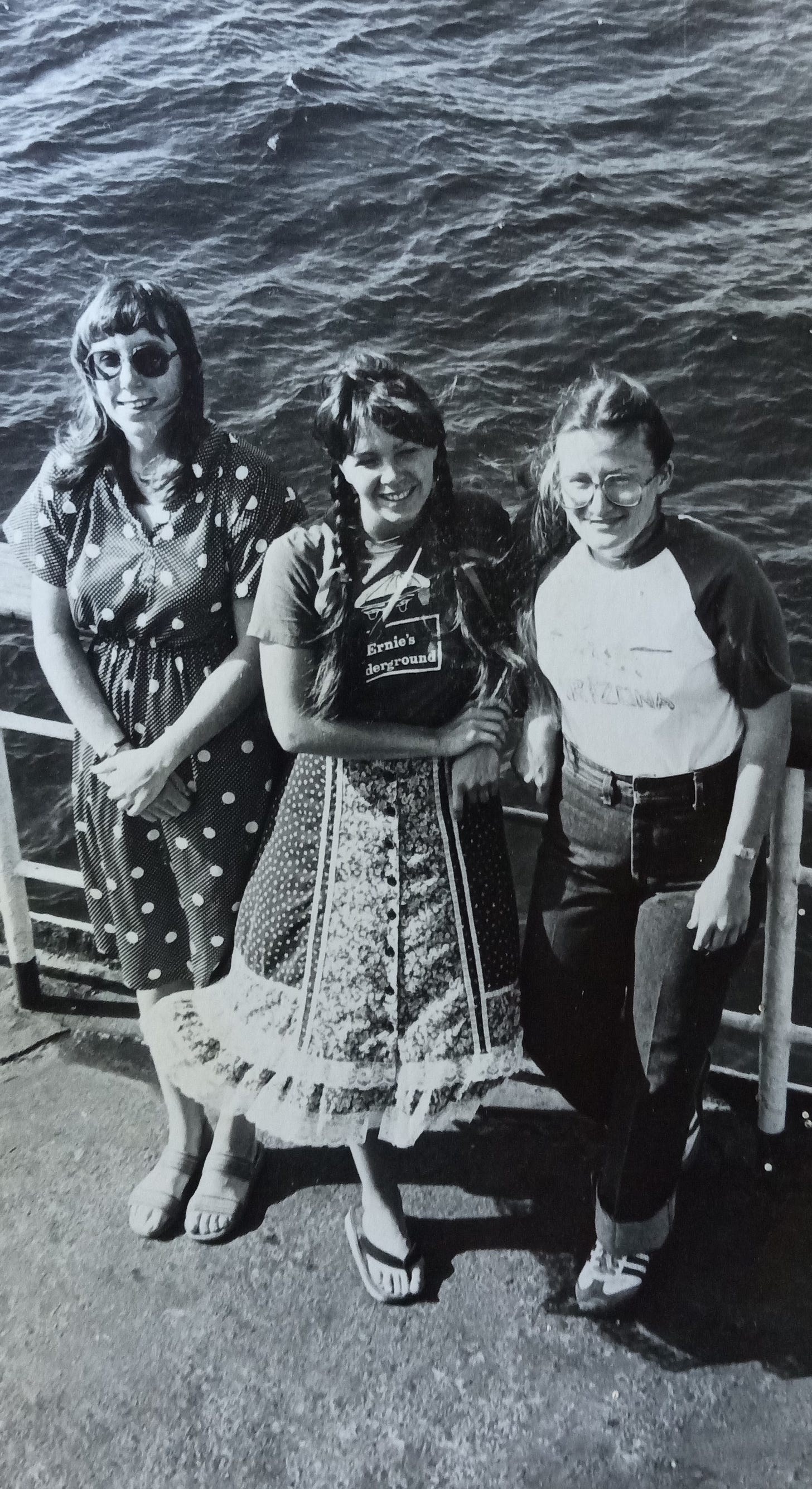
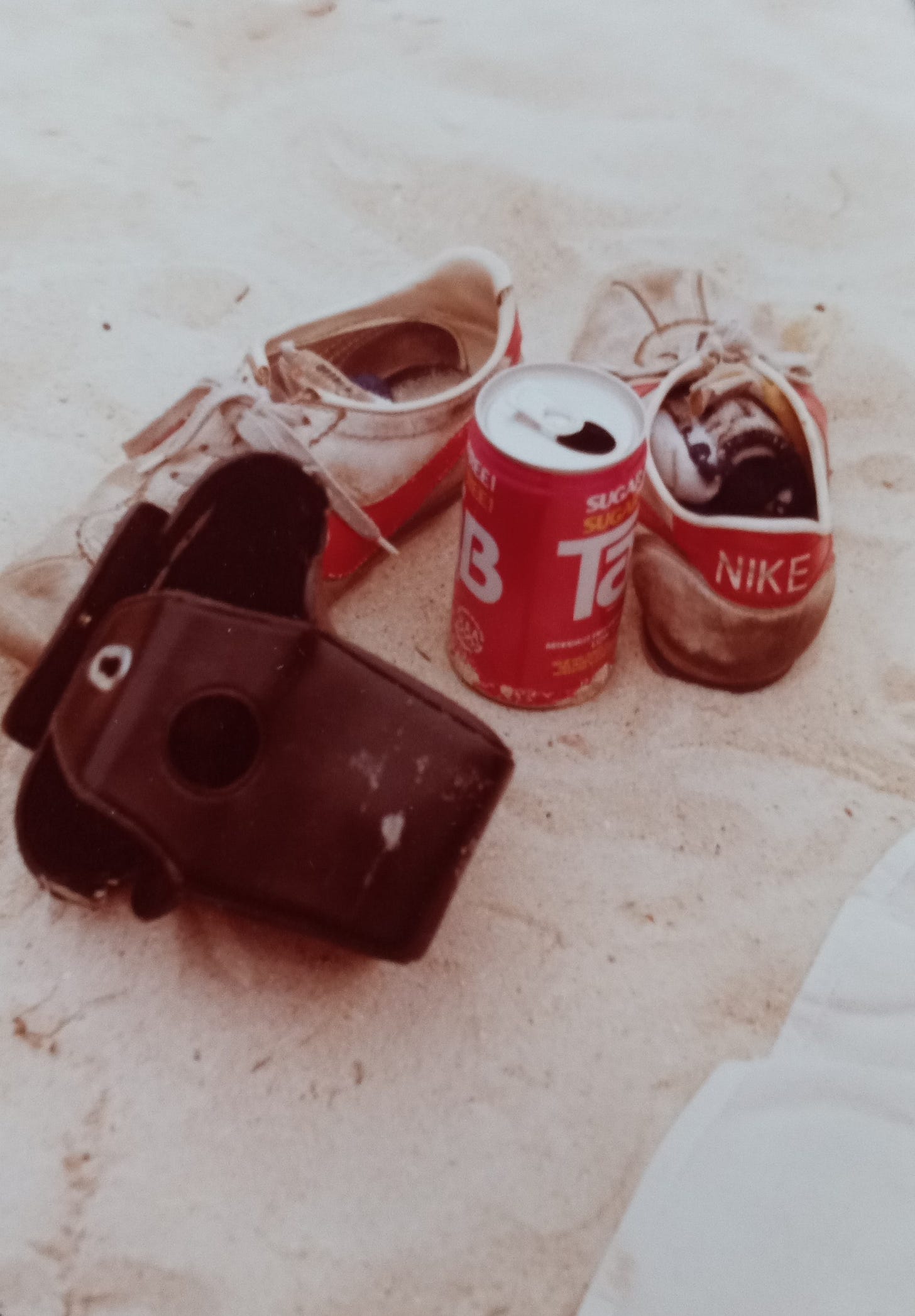
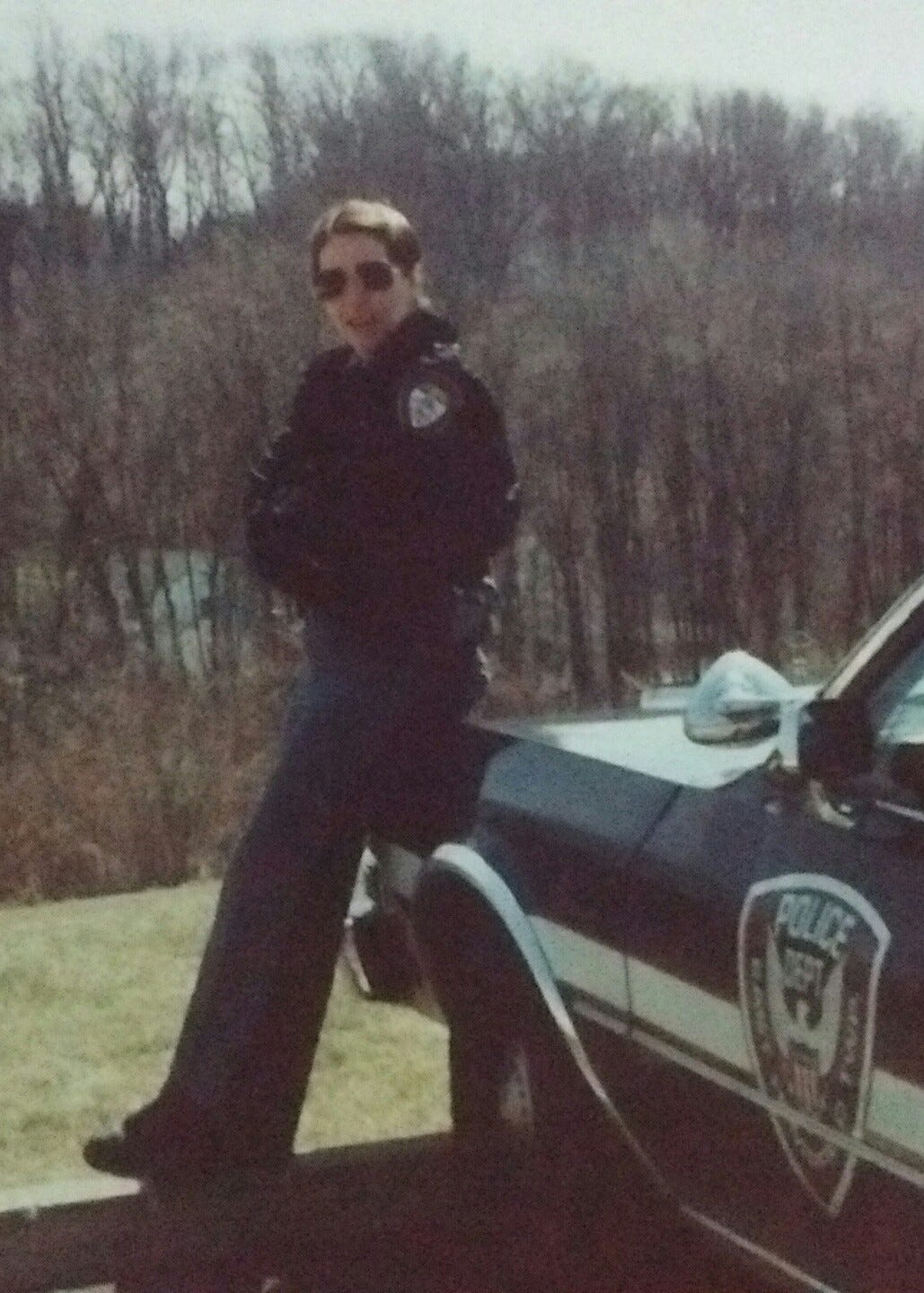
Love your adventures! So glad that you kept a journal!